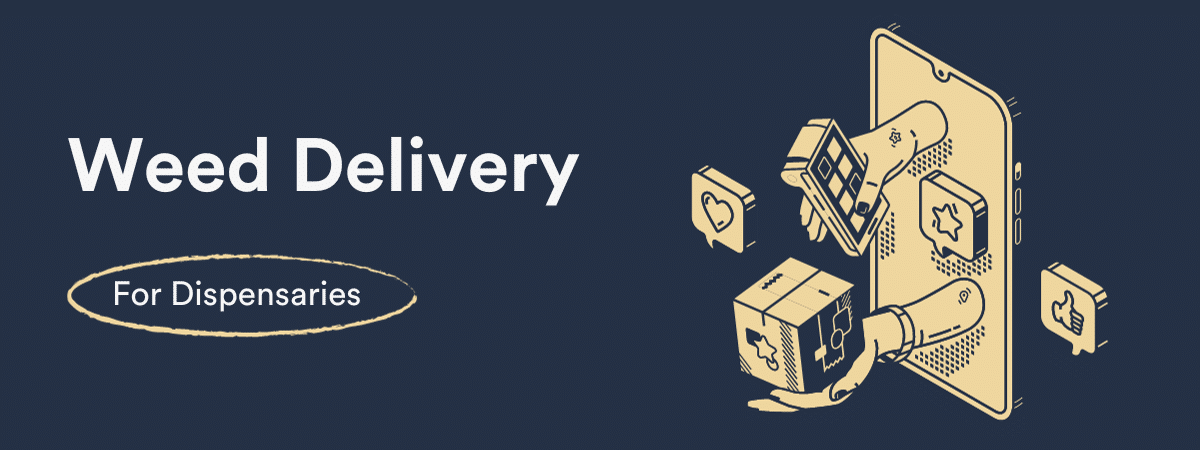So, what’s on the menu?
You’ve heard this question hundreds of times. It seems simple enough. But for dispensaries, what brands and products to put on the menu is anything but simple. As a founding partner of Tropicanna, I’ve been there, done that, and I developed these 6 questions to help you cut through the menu noise:
- What does your menu say about your brand?
- How does your menu serve your community?
- How many SKUs should be on your menu?
- How does your menu affect customer service?
- How does marketing drive menu decisions?
- How does menu improve SEO?
The answers to these questions are your roadmap to the ideal menu for your dispensary.
What Does Your Menu Say About Your Brand?
Tropicanna was a bootstrap startup so I got to wear all the hats. One of them was the buyer hat. I curated Trop’s first menu and guided years of menu evolution with the team. Beyond Tropicanna, I’ve studied more dispensary menus than I can count.
What I’ve learned is that the menu never lies. The brands and products on your dispensary’s menu tell people your brand’s story. Some examples include:
- Menus that feature sun-grown, sustainable flower from craft brands with stories that highlight environmental consciousness, equity, and inclusion.
- Menus with every flavor of artisanal concentrate and exotic cultivars that call to the connoisseur crowd.
- Menus that lean medicinal and showcase health and wellness products.
- Value menus that feature deals and discounts for the cost-conscious consumer.
- Superstore menus that try to be everything to everyone.
These are just a handful of examples. Of course, there are also generic menus that say nothing at all. Pro Tip: Don’t do that.
The central point is that the ideal menu begins with brand identity. Know who you are, who you want to talk to, and build a menu with brands and products that tell your story. But you can’t make every menu decision in a branding vacuum, either. Your menu should also serve your community. Never forget where you are.
How Does Your Menu Serve Your Community
All cannabis consumers are not the same:
- You can’t sell $60 exotic eighths to cash-strapped college students that want cheap blunt weed.
- You can’t sell high-end concentrate to soccer moms that want 2.5 MG gummies to get some sleep.
That said, it gets a bit more complex because a dispensary may serve customers beyond the local community. This was the case at Tropicanna.
When we opened Trop, Santa Ana was the only city with licensed dispensaries in Orange County. The city is blue-collar. But we also served Newport Beach, one of California’s more affluent cities. These consumers have different preferences.
The solution requires nuance. Most of our customers were from Santa Ana. Some came from Newport Beach. We crafted a menu with a foundation in brand, a heavy local Santa Ana lean, and included some fan favorites for our Newport people.
I know what you’re thinking. Why not just load that menu up superstore style and be everything to everyone? You can do that, but there are some downsides to the superstore model that you should consider.
How Many SKUs Should Be on Your Menu?
The superstore may cast a very wide net and have something for everyone, but they’re also a super nightmare for inventory management and cash flow.
Inventory Management
A superstore may feature as many as 1,500 SKUs or more. Before you go that route, consider these fun facts about managing superstore inventories:
- It requires a large inventory staff.
- It’s high-value (as much as $1M) and creates risk of loss.
- The storage/work space required increases your footprint.
- The storage area must be secure and under video surveillance 24/7.
- Intake burns $. Everything must be verified, QC’d, and entered into METRC.
- Every inventory discrepancy in METRC must be accounted for or your dispensary may be subject to fine and/or license suspension. The more SKUs you have, the harder this is to manage.
- Many cannabis products have expiration dates, different batch numbers, and SKUs are changing constantly. Tracking a large, dynamic menu eats $.
- Restocking a 1,500 SKU store also eats $ and there’s additional risk of loss every time product moves from inventory to the sales floor.
The bottom line is that the fewer SKUs you have, the less complicated, time-consuming, and expensive it is to manage. Too few is also a problem. You have to give the people what they want. Striking a balance is key. There is a point of diminishing returns in either direction (more on that in a bit.)
Cash Flow
A few key questions highlight the cash flow challenges of an outsized SKU count:
- How comfortable are you with $1M sitting in your inventory cage?
- How comfortable are you dealing with expired product?
- How comfortable are you with sluggish SKUs that must be discounted to sell because you stacked too many choices in a category?
- How comfortable are you cashing out your vendors when half their product is still on your shelf?
A SKU count balanced for variety and efficiency will mitigate these cash flow issues.
How to Find the Ideal SKU Count
Building the ideal menu for your dispensary is a process. Here are a few more points to consider when making inventory decisions:
- At Tropicanna, two brands with approximately fifty SKUs between them accounted for 20% of our sales.
- If you look at the POS data for your typical dispensary, about 12% of products make up 50% of the sales.
- Very few retailers hit the coveted $100 per ticket average, but close to 70% of the ones that do are working with less than 500 SKUs.
At Trop, I systemized this process by whiteboarding our entire inventory by product, tier/price, purchase date, remaining units, and expiration date. This made it easy to see what was working and what wasn’t. It also guided purchasing decisions. New products had to be unique or knock a poor performer off the board to make the cut.
Ok, so maybe whiteboarding is caveman tech but I could not find a platform to automate aggregation of the data I needed and the whiteboard model worked:
No more winging it and buying on gut or feel.
No more stacking categories.
Only conscious, data-driven purchasing decisions.
How Does Your Menu Affect Customer Service?
You might think that a big menu means better customer service because there’s something for everyone. That may not be the case for the following reasons:
- SKU overload leads to customer overwhelm and confusion
- Customer overwhelm leads to fewer items per ticket
- SKU overload causes budtender overwhelm and confusion
- Budtender overwhelm causes poor customer service
One of the best things you can do for your menu is eliminate meaningless choices. How many different Gelatos do you need? Maybe two so you can provide the cultivar at different price points with indoor and sun-grown options. No more.
The same can be said for just about everything on your shelf. Five different brands of 10MG gummies with the same or similar flavors, ingredients, and price points just confuses everyone and costs you time and $ to maintain.
For the best customer service, ideal menu variety is about maintaining meaningful points of differentiation between products in a category.
How Does Marketing Drive Menu?
If your menu is your brand, then your menu is marketing. Remember, a handful of brands will dominate sales. If you don’t carry them, you won’t see their customers. These are the foundational brands that you must have. But which ones are they?
The data knows. There are two types of platforms you can leverage to make the best decisions for your menu:
- Regional Sales Data: BDS Analytics, Headset, and Google Analytics are all useful platforms to track the regional and local data you need to select foundational brands for your menu.
- Your Customer Sales Data: Happy Cabbage, Tymber, and Alpine IQ are all useful platforms to track your customer data (and other performance metrics) so that you know how the brands/products on your menu are performing.
Use the first data set to build your menu and the second to make adjustments. Repeat this cycle quarterly to stay optimized. And never ever sleep on your market. It will change, again and again.
When I was at Trop I watched PlugNPlay take over the local vape market overnight. Jeeter went from “What the hell’s a Jeeter?” to the dominant Cali preroll brand in the blink of an eye. Same same for Cannabiotix. When their Cereal Milk cultivar dropped, we couldn’t keep it on the shelf. In cannabis retail, if you snooze, you lose.
How Does Your Menu Improve SEO?
Cannabis is evolving. Consumers are becoming more sophisticated. Brand awareness is on the rise and that means brand searches are on the rise. Carrying the “most searched” brands in your region is a good idea. Ranking for those brands is a better one.
If you used the data from the previous section, you should already have the foundational brands that people search for on your menu. But can Google read your menu? That depends on your menu tech. There are a few dispensary menu solutions with different SEO capabilities.
Iframe Menus
These are the most popular solutions because they’re so easy to use. Drop a code line on your website, and you’re up and running. But Google has a hard time reading iFrame menu content so there’s no SEO value.
SEO Optimized Menus
Companies like Dispense and Tymber offer menu solutions that Google can read. This means your site can rank for product keywords like Blue Dream or brands like 710 Labs.
Custom Menus
These can be expensive, but they may offer the best integration, are optimized for SEO, and raise no data ownership issues.
Conclusion: This might piss off the folks at Dutchie, but I’m over it. They need to step it up. If you want to rank for brands, forget the iFrame. SEO-optimized and custom menus are the only way to go.
Build The ideal Dispensary Menu
The ideal dispensary menu is a moving target that evolves with industry trends. It demands a complex matrix of decision-making that should balance the answers to these questions:
- What does your menu say about your brand?
- How does your menu serve your community?
- How many SKUs should be on your menu?
- How does your menu affect customer service?
- How does marketing drive menu decisions?
- How does menu improve SEO?
Answer these and you will have the framework to answer the one question that really matters for your dispensary:
So, what’s on the menu?
Contents
- What Does Your Menu Say About Your Brand?
- How Does Your Menu Serve Your Community
- How Many SKUs Should Be on Your Menu?
- Inventory Management
- Cash Flow
- How to Find the Ideal SKU Count
- How Does Your Menu Affect Customer Service?
- How Does Marketing Drive Menu?
- How Does Your Menu Improve SEO?
- Iframe Menus
- SEO Optimized Menus
- Custom Menus
- Build The ideal Dispensary Menu
JP Donahue is a former corporate litigator turned successful writer, with over 25 works produced for major film and TV studios. He's also a founding partner of Tropicanna, one of Orange County's top cannabis retail brands. Leveraging his experience in both Hollywood and cannabis, JP advises dispensaries on branding, marketing, and operations. He's a Jiu Jitsu Black Belt, certified Yogi, meditator, dog father, and a member of the New York State Bar and Writers Guild of America West.



